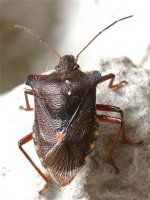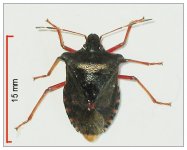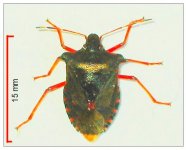harry eales
Ancient Entomologist
J Duffie said:Hi,
about 5 shield bugs around the garden moth traps this morning. Here is a picture of one. I guess from above it is Hawthorne or Birch but not sure how to separate. If you let me know I will try to id them in future
Thanks,
Jamie
Hello Jamie,
You have a Birch Shieldbug Elasmostethus interstinctus. The Hawthorn Shieldbug Acanthosoma haemorrhoidale is larger and has differently shaped 'shoulders'. A picture of this latter species can be seen in post #42 picture 1 in this thread (page 2).
The best readily available book on these 'bugs' is Roger D. Hawkins Shieldbugs of Surrey. It contains photographs of all the British species, and many nymphs and identification keys. At £15 for a hardback book it is very good value for money.
There are a good number of Shieldbugs displayed on the following website:-
http://www.bioimages.org.uk/
Some 14 species have been recorded from Northumberland and Durham. perhaps half of which are relatively common, or likely to be met with by the casual observer. If you have any problems with ID send me or post a picture here.
Harry







